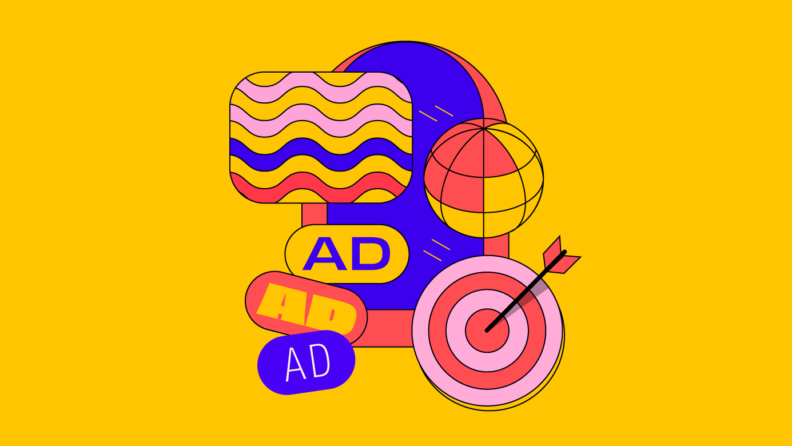Delivering personalized and relevant content that resonates with customers increases engagement and drives conversions. This is particularly true when implementing account based marketing, or ABM.
ABM involves targeting specific, high-value accounts, and designing campaigns that speak directly to decision-makers. Businesses that excel in personalization achieve positive results by customizing their offerings and outreach to the right individual, at the right moment, and with the right experiences.
In this article, I’ll explore some of the key principles of targeted content creation, how they align with best practices for abm, and walk you through the step-by-step process of creating your own targeted content strategy.
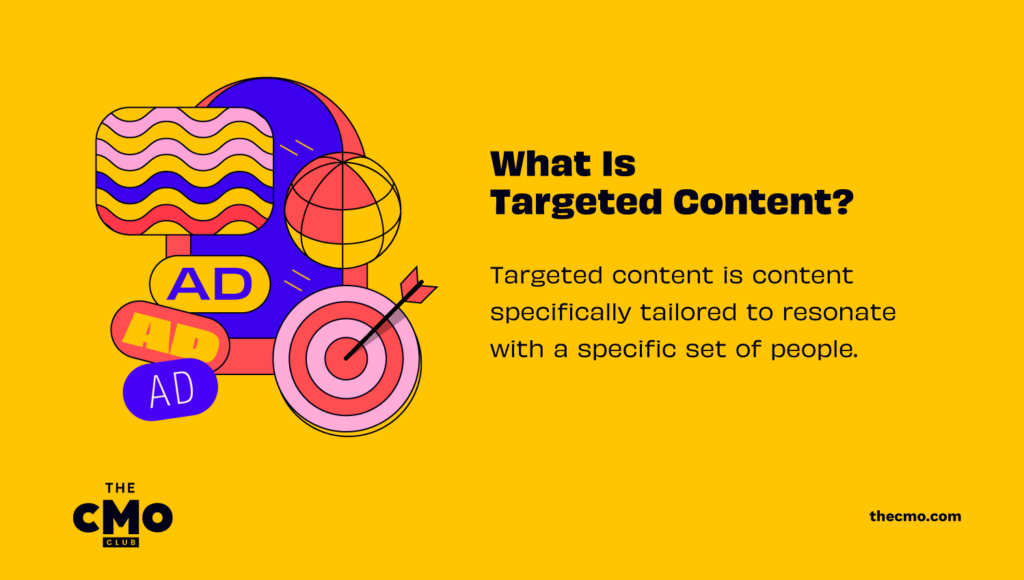
What Is Targeted Content?
Targeted content is content specifically tailored to resonate with a specific set of people. It is a crucial aspect of your target account marketing strategy and holds immense potential for building close, authentic relationships.
The Importance of targeted content in ABM
If you’ve ever been on the receiving end of an email that begins with “dear valued customer,” you know it can leave you feeling less than valuable.
Why is that?
This lack of personalization is the polar opposite of targeted content. The result is generic, one-size-fits-all messaging that makes virtually no impact on the reader. Not only are impersonal emails ineffective, they can actually cause a customer to feel unimportant and lose trust in the brand altogether.
In the case of account-based marketing, ABM personalization becomes even more important as the entire strategy revolves around heavily focusing on a single account or business. The ideal marketing campaign in your ABM strategy takes this targeting to the next level by leveraging relevant data to create compelling content that appeals directly to key stakeholders of the account.
How To Create A Targeted Content Strategy
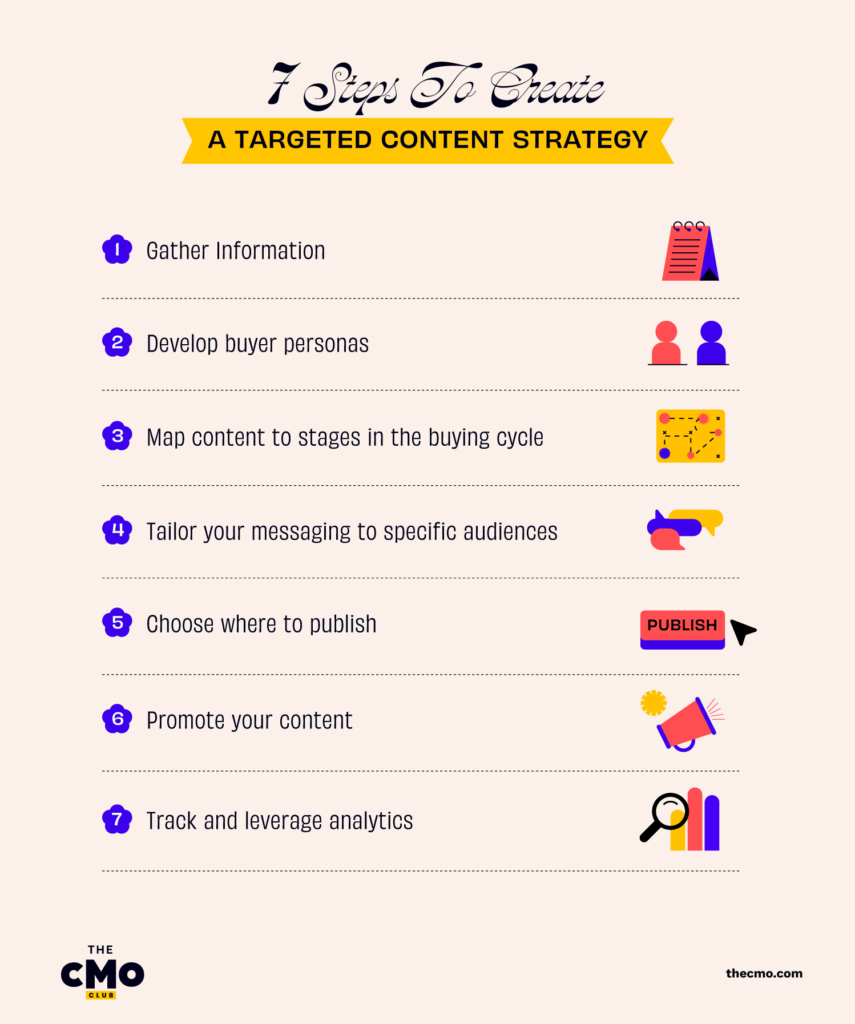
1. Gather information on your target audience
For your strategy to be effective, you need to tailor your value proposition to address the goals of each target account, and what’s standing in the way. By addressing their specific pain points, you can come up with a compelling message that clearly communicates the unique value your product or service provides to the organization.
It is crucial to thoroughly understand the detailed pain points, needs, and goals of each account, emphasizing how your offering effectively resolves those specific challenges, and ensuring your messaging remains consistent with the brand while avoiding generic statements.
To do this, try reviewing mining. Read product reviews, customer testimonials, help forums, social media, and anywhere else that customers give feedback. This will help you to answer questions like:
- What are the tasks your customers struggle with each day?
- What do they love?
- What do they hate?
- What questions are they likely to ask?
2. Develop buyer personas
Coming up with buyer personas enables you to customize your content, messaging, product offerings, and services to align with the specific requirements, behaviors, and concerns of your target audience.
Buyer personas are the key to personalizing your marketing efforts, informing product development, optimizing content strategies, and tailoring your products' messaging to effectively connect with your ideal customers.
Here are some demographic metrics you can use to define buyer personas:
- Industry
- Company size
- Location
- Annual revenue
- Budget
As well as some behavioral insights:
- Motivations
- Expectations
- Pain points
You can develop buyer personas by conducting research, surveys, and interviews involving a combination of customers, prospects, and individuals who share similarities with your target audience but aren’t in your existing contact database.
- Look for trends in your contact database: This will give you insight into how people find and engage with your content. Look for patterns in their behavior, such as the channels they use to discover your content or the types of content they consume the most.
- Talk to your sales team: Your sales team is likely one of your most underutilized resources. Because they interact the most with leads, they can offer valuable insight into the types of leads who tend to convert into customers and how they get there.
- Conduct interviews with both customers and prospects: Direct feedback can help you to better understand what they appreciate about your product or service, revealing unique value propositions and informing future marketing strategies.
3. Map content to stages in the buying cycle
Awareness
At the awareness stage of the ABM funnel, the buyer is doing high-level research, collecting information, gathering insights, and exploring different perspectives.
Blog posts, eBooks, and white papers are ideal content marketing assets to target leads at this stage of the buyer’s journey. They can help to educate, address pain points, and provide the individual with more information to guide them in their decision-making.
Consideration
At the consideration stage, the buyer dives deep into your offering, carefully considering if it meets their needs.
Case studies are an excellent tool to demonstrate the results you’ve achieved for your clients, and why your offering is the best solution for a lead who’s at the consideration stage of the buyer’s journey.
Decision
The decision stage is crunch time. It’s where potential customers start narrowing down their options and taking the steps to become customers.
Offering your prospect a free trial is one of the best ways to seal the deal. By letting your buyers take your product for a test run, they can make sure it works for them and put to rest any lingering doubts.
4. Tailor your messaging to specific audiences
Remember when I said ABM personalization is important? Start by getting clear on your brand message, then use audience segmenting to group your prospects according to their stage of the buyer’s cycle. Each group should have its own unique messaging because your goal for addressing each audience is different.
At the awareness stage, you want to create content that speaks to your audience in a language they understand; by showing them that you have a unique knowledge of their pain points and are an expert source for information on the topic.
At the consideration stage, you can safely assume that they have a basic understanding of your brand and are interested in learning more. Strengthen the relationship by breaking your brand message down into actionable advice that your audience can use to make their lives easier right now. This shows your audience you care about them—whether you have their buy-in yet or not.
Once they've reached the decision-making stage, you’ve already established some trust. Now’s your chance to highlight how your unique solution can effectively solve their problem.
5. Choose where to publish
Creating your buyer personas should give you a sense of who you’re marketing to, but also where they are. To create a content distribution plan, consider your channel options as well as the type of content you want to share:
- Paid distribution channels like a Google Ads campaign can attract new audiences or people who are tangentially connected to your brand online. Paid distribution channels depend on quickly capturing attention and creating a positive impact, so push content that is highly useful, entertaining, or meaningful.
- Owned distribution channels like your website, blog, email marketing, and social media profiles such as LinkedIn offer full control over content and messaging, allowing you to tailor your communication directly to your audience without additional costs.
- Earned distribution channels such as press coverage, influencer partnerships, and guest blogging rely on building credibility and trust through third-party endorsements, expanding your reach through the networks of others.
- Shared distribution channels like co-branded content, joint promotions, or cross-promotional campaigns amplify your message by tapping into existing communities or networks.
By diversifying your distribution strategy across these channels and tailoring your content to fit each platform's unique characteristics, you can effectively reach and engage your target audience across various touchpoints in their customer journey.
6. Promote your content
Crafting an effective marketing message involves not only the content but also the tone and delivery. Keeping the customer experience top of mind helps to maintain brand integrity and engagement. Here’s some advice for promotion:
- Be mindful of editorial guidelines of both earned and paid channels: The requirements and style of each third-party channel will influence your promotional message.
- Align your distribution messaging with the preferences of your target audience: When distributing multiple content pieces simultaneously on a single topic, make sure they are all addressing the needs of your audience.
- Consistent tone of voice: Lastly, maintaining a consistent tone of voice across all platforms is key, whether it's a promoted blog post, sponsored social media update, or email campaign.
7. Track and leverage analytics
One of the biggest ABM mistakes people make is failing to continuously review the performance of their content and continuing to optimize over time.
Experimenting with various content formats, tones, and styles is key to determining the most effective approach for your audience segment. Evaluate your engagement rates, click-through rates, reach, and other metrics to continually improve your SEO (psst, we have an SEO cheat sheet to help you keep up with changing algorithms) along with your content marketing strategy.
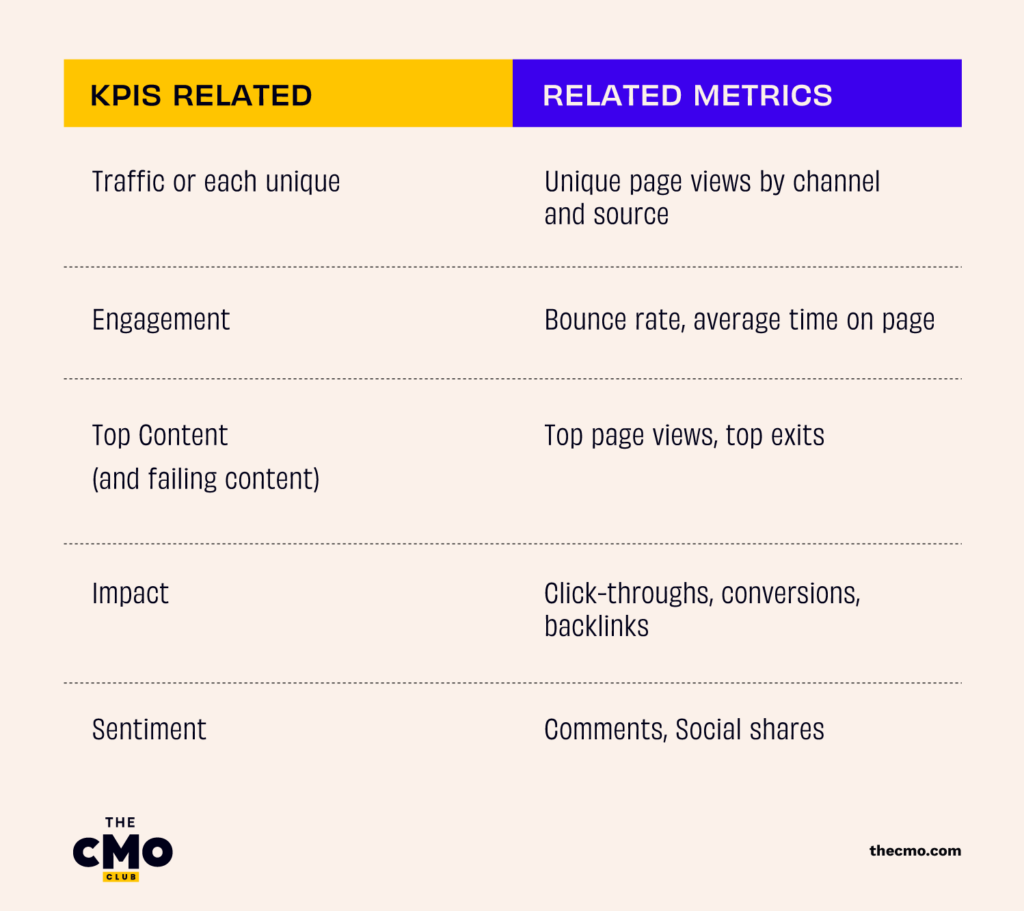
Benefits of Targeted Content
Improved timing and reach
A well-thought-out targeted content plan also takes into consideration content distribution. Posting your content while your audience is most active and involved is more likely to catch their attention and increase ABM engagement. That means more visibility and ultimately, greater reach.
Reduced time creating content
A targeted approach allows you to streamline the content creation process by eliminating the need for extensive research and iterations to make the content relevant and engaging to a wider audience. Targeted content also tends to resonate more deeply with its intended audience, reducing the time spent on revisions and adjustments to align with audience preferences.
Improved brand perception
What do Marlon Brando and successful marketers have in common? They know how to make someone an offer they can’t refuse.
Digital marketing requires you to think about the value you can offer your ideal client. Even though you might be trying to sell something, the key is to position it in such a way that it makes it very difficult for your customer to say no. This generally looks like identifying one of their major pain points, something that would be a game changer for their business, and demonstrating your ability to deliver this result to them on a silver platter. If you’re able to do this, your chances of success skyrocket.
Examples Of Targeted Content
1. Spotify’s Discover Weekly Playlist
Every Monday, Spotify's Discover Weekly feature delivers a personalized playlist of 30 songs to users, using AI technologies such as collaborative filtering and natural language processing to curate the list according to their listening history and preferences.

2. Drift’s Chatbot
By customizing their chatbot to align seamlessly with their content and target audience, Drift ensures that once a user visits their website, the chatbot captures their interests, preferences, and pain points, and directs them towards resources that cater to their specific needs.
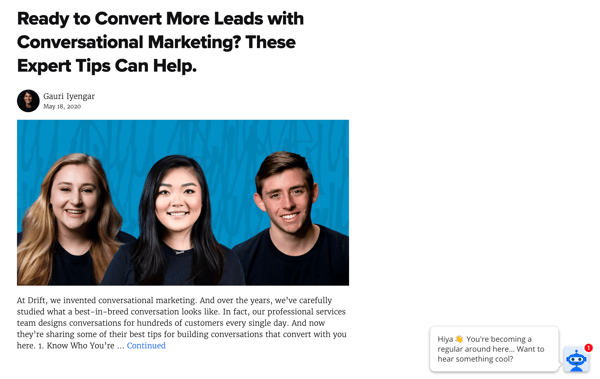
3. Shoprenter
Shoprenter boosted lead conversion rates by 12.4% by personalizing their homepage content for Google Ads keywords. For instance, users searching "opening an online store" saw one message:
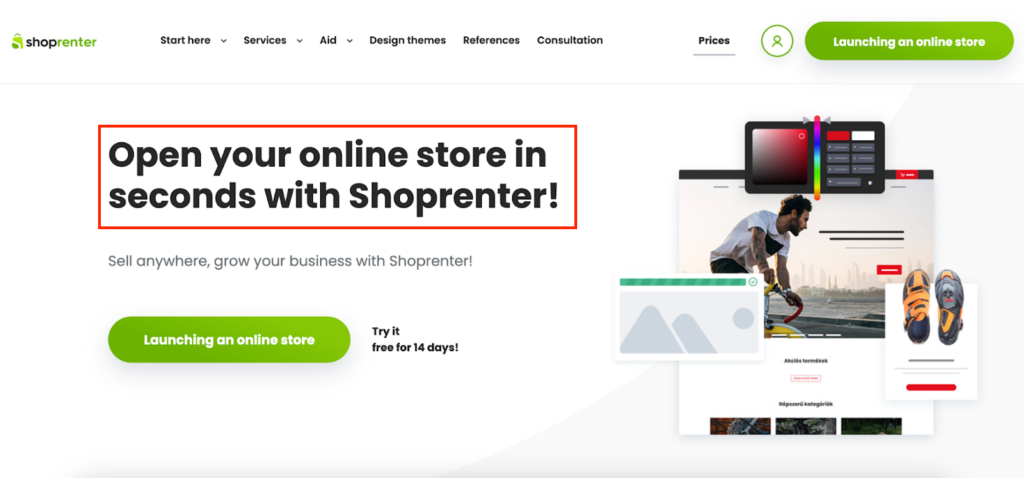
While users who included “shopify” in their search saw an entirely different message altogether:
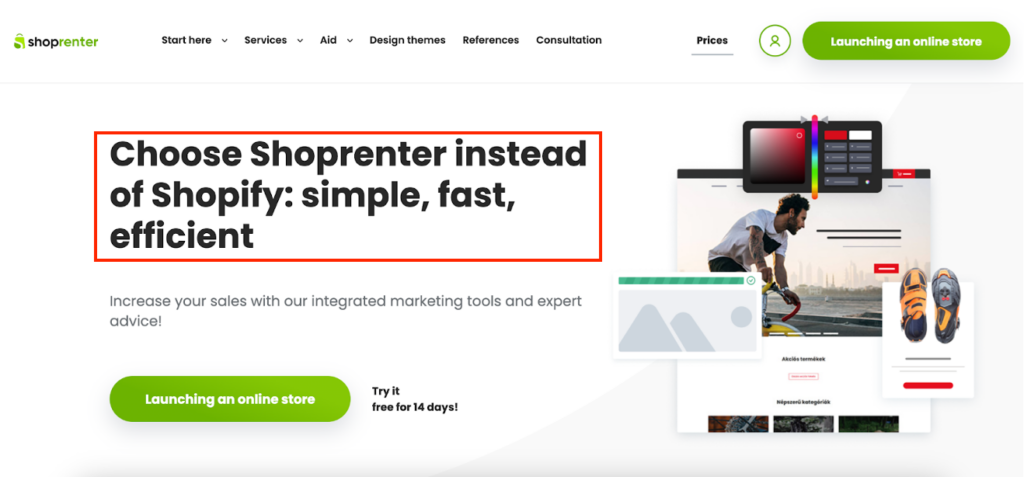
The Role Of AI In Targeted Content Marketing
AI uses natural language processing (NLP) to analyze user-generated content such as social media posts and reviews to identify key themes and sentiments. By sorting through large volumes of text data, NLP algorithms can extract valuable insights, understand sentiment, and identify trends, helping you better understand your audience and tailor content to them.
Predictive modeling involves analyzing various data sources, including search history, purchase history, and social media activity, to forecast future behavior and preferences. Through the use of machine learning algorithms, AI identifies patterns in user behavior and predicts what types of content will be most relevant or engaging to individuals. This can help you to anticipate customer needs and interests, so you can create targeted content that resonates.
Dynamic content targeting involves modifying content in real-time based on user behavior and preferences. AI algorithms continuously analyze user interactions, such as clicks, likes, and browsing history, to personalize content delivery. By dynamically adjusting content based on individual preferences and behaviors, you can enhance user experience and increase engagement rates.
These technologies can analyze large amounts of customer data to deliver personalized experiences in real-time, and it’s worth your while to explore how they might be able to support your targeted content marketing efforts.
While you’re re-evaluating your tech stack, why not check out our list of the best account based marketing software to help streamline your target account selling efforts.
Tools For Creating Targeted Content
Account-based marketing software
Account-based marketing (ABM) software is a specialized tool designed for executing and managing marketing strategies focused on specific, high-value customer accounts. It provides analytics and insights on account interactions, helping businesses to tailor their approach through—you guessed it—targeted content (among other things).
Some of the best account-based marketing software includes:
- Uberflip, for managing content throughout the entire sales funnel
- 6sense, for AI modeling based on intent da
- DemandBase, for ABM advertising
Marketing automation software
Another platform you should consider for your targeted content strategy is marketing automation software. It streamlines and automates marketing tasks such as email marketing, social media posting, and ad campaigns, and enables businesses to target customers with automated (and in this instance, targeted) messages across email, web, social, and text.
Some of the best marketing automation software includes:
- SimpleTexting, for text automation
- Ahrefs, for automating brand mentions
- EngageBay, for small businesses
Join For More Targeted Marketing Insights
Targeted content plays a pivotal role in account-based marketing (ABM), but it can really be used in all kinds of marketing strategies. By understanding specific audience needs, developing buyer personas, and mapping content to different stages of the buying cycle, you too can begin to build meaningful relationships with your customers through content created just for them.
As I wrap things up, let me leave you with these three key takeaways:
- Effective targeted content requires a deep understanding of specific high-value accounts, the decision makers at those accounts, and their unique needs.
- AI tools and technologies can be helpful in analyzing customer data and optimizing content personalization.
- Selecting the right ABM and marketing automation software can significantly enhance targeted content strategies. I hope my recommendations help!
If you enjoyed this article, subscribe to The CMO newsletter to receive the very best marketing tips, trends, and expert insights straight to your inbox.

